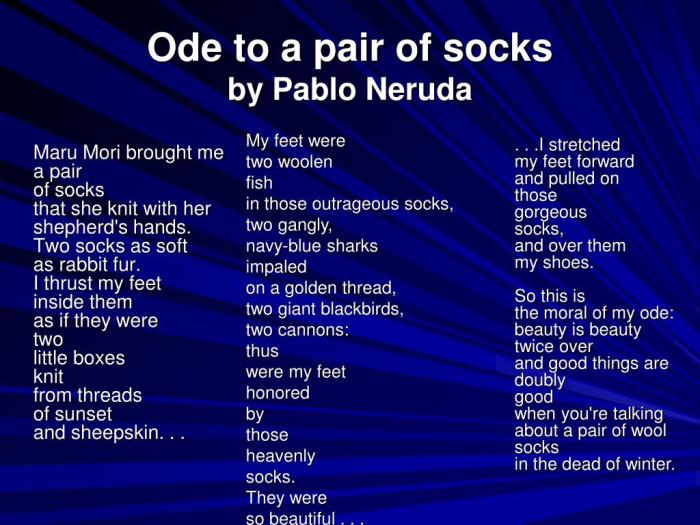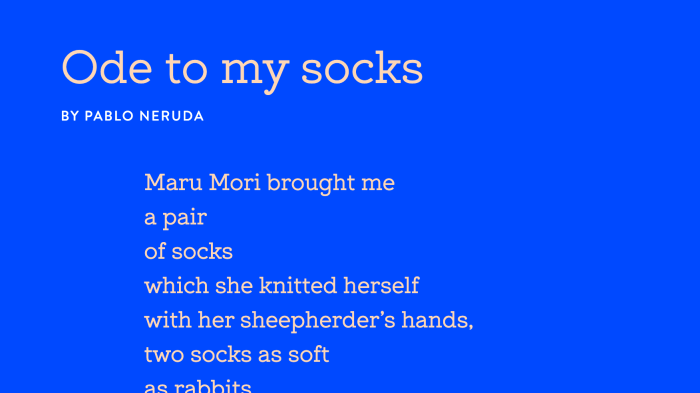Ode to my socks analysis – Embark on an enthralling literary journey with our comprehensive analysis of Pablo Neruda’s “Ode to My Socks.” Prepare to delve into the rich tapestry of historical context, structure, themes, language, and the profound connections that make this poem an enduring masterpiece.
Pablo Neruda’s “Ode to My Socks” stands as a testament to the transformative power of everyday objects, inviting readers to contemplate the beauty and significance found in the mundane.
Historical and Cultural Context

Odes, a time-honored literary genre, have played a significant role in human history and culture. Their origins can be traced back to ancient Greece, where they were performed by poets to celebrate gods, heroes, or significant events.
Evolution of Odes
Over time, odes evolved to reflect the changing societal and cultural norms. During the Renaissance, they became popular for expressing personal emotions and experiences. In the Romantic era, they often celebrated nature and the sublime.
Famous Odes and Their Impact
- Pindar’s “Odes”: Celebrated Greek athletes and their victories, shaping the genre’s association with praise and admiration.
- Horace’s “Odes”: Introduced Roman audiences to the genre, influencing the development of Latin poetry.
- John Keats’s “Ode to a Nightingale”: A Romantic masterpiece that explores themes of mortality and the beauty of nature.
- Pablo Neruda’s “Ode to Tomatoes”: A 20th-century ode that celebrates the ordinary and the overlooked.
Structure and Form: Ode To My Socks Analysis
An ode typically follows a structured form, employing stanzas, rhyme schemes, and meter to convey its message.
Stanzas, which are groups of lines, provide a framework for the ode’s content. The number and length of stanzas can vary, allowing poets to shape the poem’s rhythm and pacing.
Rhyme Schemes
Rhyme schemes, the patterns of rhyming words at the ends of lines, contribute to the musicality and memorability of an ode. Common rhyme schemes include ABAB, ABCB, and AABB, where letters represent rhyming lines.
Meter
Meter refers to the rhythmic pattern created by the number of stressed and unstressed syllables in each line. Iambic pentameter, with five pairs of unstressed and stressed syllables, is a common meter used in odes, providing a stately and elevated tone.
The combination of stanzas, rhyme schemes, and meter creates a structured and harmonious framework that enhances the impact of the ode’s message.
Themes and Motifs

Odes, as a literary form, often explore common themes and motifs that transcend specific works. These themes and motifs are expressed through literary devices such as imagery, symbolism, and metaphor, enriching the meaning and impact of the poem.
Celebration of the Ordinary
One prevalent theme in odes is the celebration of the ordinary and mundane. Poets use odes to elevate everyday objects or experiences, bestowing upon them a sense of significance and grandeur. This theme is evident in “Ode to My Socks,” where the speaker exalts the humble socks, recognizing their essential role in daily life.
Language and Style

Pablo Neruda’s “Ode to My Socks” is a playful and affectionate poem that celebrates the simple, everyday object of socks. Neruda uses a variety of literary devices to create a vivid and engaging portrait of his socks, including figurative language, sensory details, and humor.
Figurative Language
Neruda uses several types of figurative language in “Ode to My Socks,” including metaphors, similes, and personification. For example, he compares his socks to “two fish made of wool” and “two timid hares” (lines 3-4). These comparisons help to create a sense of intimacy and affection between the speaker and his socks.
Sensory Details
Neruda also uses a variety of sensory details to create a vivid and engaging portrait of his socks. For example, he describes the socks as being “soft” and “warm” (line 1), and he uses the word “scratch” to describe the feeling of putting on new socks (line 7). These sensory details help the reader to imagine the socks and to feel the speaker’s affection for them.
To fully grasp the intricate themes and literary devices employed in “Ode to My Socks,” a comprehensive analysis is essential. To enhance your understanding, consider delving into ap csp practice exam pdf , which provides valuable insights and practice materials.
Returning to the analysis of “Ode to My Socks,” its exploration of the mundane and the profound offers a poignant reminder of the significance found in the ordinary.
Humor
Neruda’s poem is also full of humor. For example, he describes his socks as being “full of holes” and “darning” (line 10). He also compares his socks to a “pair of clowns” (line 12). These humorous elements help to create a light-hearted and playful tone in the poem.
Neruda’s use of language and style in “Ode to My Socks” helps to create a vivid and engaging portrait of his socks. The poem’s use of figurative language, sensory details, and humor makes it a memorable and enjoyable read.
Personal and Universal Connections

In “Ode to My Socks,” Pablo Neruda explores the intimate and personal relationship between an individual and their socks. Through vivid imagery and heartfelt emotions, the poem resonates with universal human experiences, connecting with readers on a profound level.
The Personal Experience
Neruda’s ode captures the simple yet profound joy of putting on a fresh pair of socks. The poet describes the socks as “humble” and “pure,” emphasizing their essential role in daily life. The act of donning socks becomes a ritual that provides comfort and a sense of belonging.
The Universal Connection
The poem’s personal experiences extend beyond the individual to connect with universal human experiences. The socks represent the everyday objects that bring us comfort and familiarity. They are a reminder of our shared humanity and the simple pleasures that make life worth living.
Examples of Personal Resonance
- Readers may recall the feeling of putting on a fresh pair of socks after a long day, experiencing the same sense of warmth and comfort described by Neruda.
- The poem’s celebration of the mundane resonates with those who appreciate the beauty in everyday moments.
- Neruda’s ode encourages readers to find joy in the simplest things, reminding them that happiness can be found in the most unexpected places.
Critical Reception and Legacy

Pablo Neruda’s “Ode to My Socks” has received critical acclaim for its unique blend of everyday imagery and profound philosophical reflections. Critics praised the poem’s simplicity, humor, and ability to elevate the mundane to the level of the sublime.
Influence on Other Poets and Literary Works
Neruda’s poem has inspired numerous other poets, including Charles Bukowski, Billy Collins, and Wislawa Szymborska. Its influence can be seen in works that explore themes of everyday life, the body, and the search for meaning in the ordinary.
Contemporary Relevance and Meaning, Ode to my socks analysis
In contemporary society, “Ode to My Socks” continues to resonate with readers due to its timeless themes of gratitude, acceptance, and the interconnectedness of all things. The poem reminds us to appreciate the simple pleasures in life and to find beauty and meaning in the most unexpected places.
FAQ
What is the main theme of “Ode to My Socks”?
The main theme of “Ode to My Socks” is the celebration of the ordinary and the appreciation of the simple things in life.
How does Neruda use language and imagery in “Ode to My Socks”?
Neruda uses vivid imagery and sensory details to bring the socks to life, creating a sense of intimacy and connection between the speaker and the object.
What is the significance of the socks in the poem?
The socks represent the everyday objects that often go unnoticed and unappreciated. Through the socks, Neruda highlights the beauty and importance of the mundane.